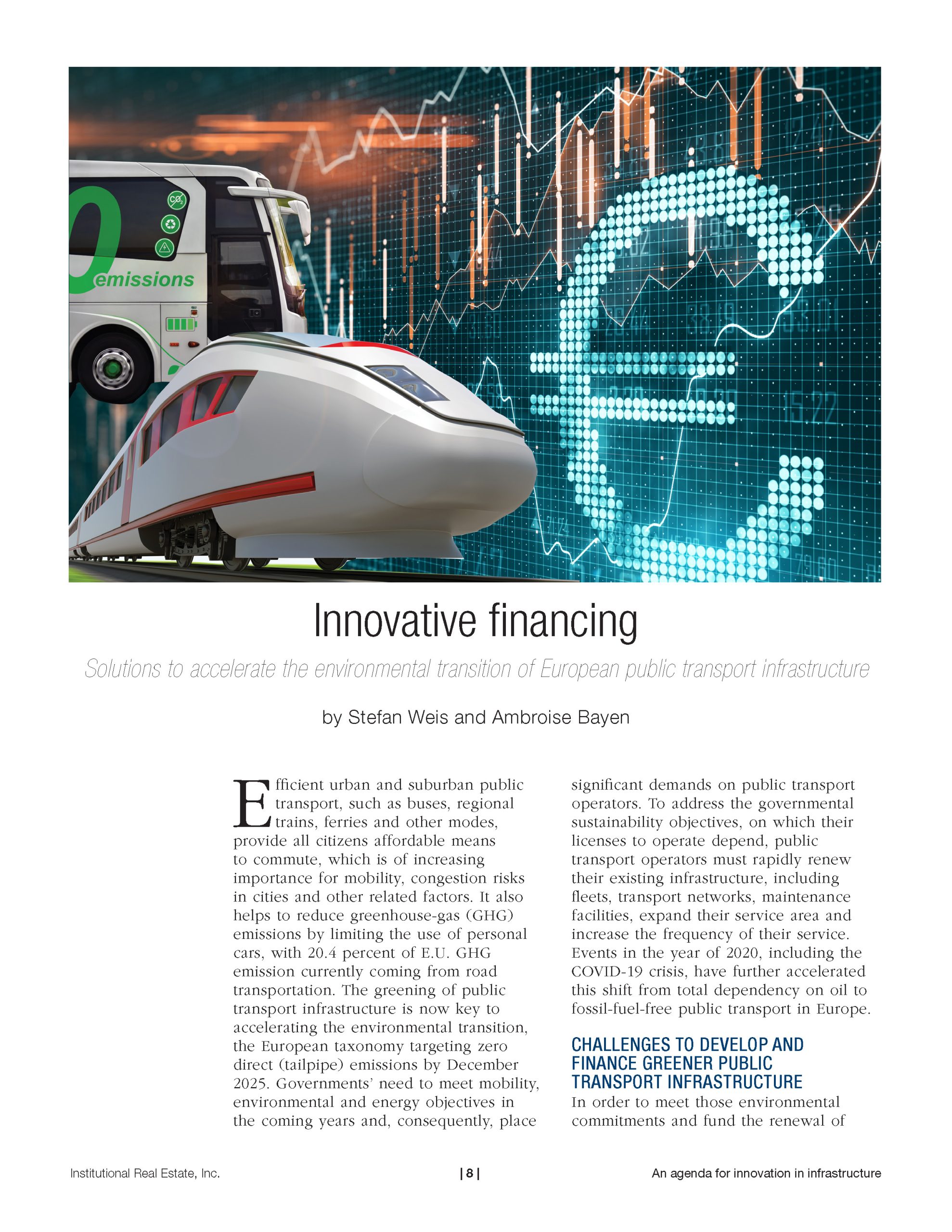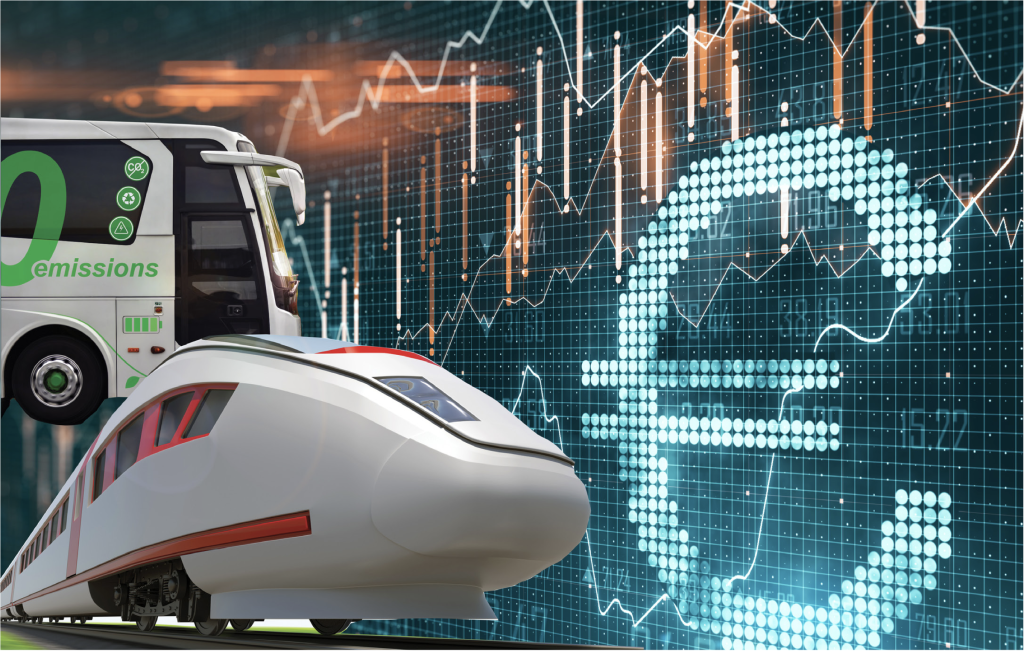by Stefan Weis and Ambroise Bayen
Efficient urban and suburban public transport, such as buses, regional trains, ferries and other modes, provide all citizens affordable means to commute, which is of increasing importance for mobility, congestion risks in cities and other related factors. It also helps to reduce greenhouse-gas (GHG) emissions by limiting the use of personal cars, with 20.4 percent of E.U. GHG emission currently coming from road transportation. The greening of public transport infrastructure is now key to accelerating the environmental transition, the European taxonomy targeting zero direct (tailpipe) emissions by December 2025. Governments’ need to meet mobility, environmental and energy objectives in the coming years and, consequently, place significant demands on public transport operators. To address the governmental sustainability objectives, on which their licenses to operate depend, public transport operators must rapidly renew their existing infrastructure, including fleets, transport networks, maintenance facilities, expand their service area and increase the frequency of their service. Events in the year of 2020, including the COVID-19 crisis, have further accelerated this shift from total dependency on oil to fossil-fuel-free public transport in Europe.
CHALLENGES TO DEVELOP AND FINANCE GREENER PUBLIC TRANSPORT INFRASTRUCTURE
In order to meet those environmental commitments and fund the renewal of public transport assets, all stakeholders, including governments, local authorities and public transport authorities (PTAs), are exploring new ways to establish environmental objectives while attracting new investors.
From a public perspective, local authorities and PTAs have launched ambitious plans to develop cities and regional public transport networks, while renewing the existing infrastructure. In Nordic European countries, the use of energy-efficient public transport has been scaled up and an increasing number of new contracts now include requirements or incentives to invest in green assets, such as electric buses and hydrogen ferries.
In addition to the investment requirements to improve public transport infrastructure, PTAs are also increasingly integrating wider environmental, social and governance (ESG) criteria into the evaluation of their tender procedures. Although price usually remains an important parameter to award a contract, ESG elements can now serve as a differentiator on a tender bid,
as ESG often accounts for more than 50 percent of the evaluation in many European countries. The tender procedures also factor in incentives, beyond the shift toward greener fleets, to improve other aspects of their ESG performance during the life of the public contract. As public transport contracts have a relatively long duration and are most often availability based, such incentives are necessary to achieve ESG objectives.
From a private perspective, public transport operators have to develop innovative financing to cope with increasing capital expenditure need, as well as PTAs’ requirements. Sustainable debt instruments (e.g., ESG-linked loans or sustainability-linked loans) are tools that operators have started to use to finance their transition toward a greener infrastructure. Aside from the potential financial benefits (longer tenor and decreasing interest rates), these loans provide operators with the opportunity to drive their corporate strategy toward broader sustainability targets.
DEVELOPMENT OF ESG-LINKED LOANS IN EUROPE
The sustainable finance market in Europe, and more particularly the emission of ESG loans, has grown significantly in the past year: ESG-linked loans increased by 191 percent to €78.6 billion ($90.7 billion) in second quarter 2021 from €27.0 billion ($31.1 billion) in second quarter 2020, according to the Association for Financial Markets in Europe’s second quarter 2021 ESG Finance Report. This development stems from a range of factors such as the COVID-19 pandemic, development of new financial tools, and more advanced standards for sustainable finance instruments and ESG disclosure. Building upon this consensus, the financial services industry stepped up with multiple pledges from various European banks. ESG-linked loans are likely to become a standard feature of financing products. In the near future, there may no longer be a discernible distinction between sustainable and traditional funding.
Existing ESG loans generally fall into two categories:
- Green loans, which are to be applied for the sole purpose of a specific environmental impact project (i.e., an eligible green project as defined by the Loan Market Association).
- ESG-linked loans, which contain a feature whereby the performance
of the borrower is measured against ESG metrics and KPIs, with that performance triggering predefined outcomes.
Unlike green loans, the use of proceeds in relation to an ESG-linked loan is not a determinant in its categorization and, in most instances, those loans are used for general corporate purposes. The flexibility over how the proceeds are spent explains why ESG-linked loans are so popular. The company is simply tested, at regular intervals during the life of the loan, through KPIs measuring its progress toward agreed sustainability performance targets. Typically, the interest rate is reduced when the borrower satisfies a target threshold or vice versa. The mechanics for this are straightforward and similar to a margin ratchet based on financial ratios. ESG-linked loans consequently create real financial incentives for the borrower to improve its overall sustainability performance. In order to avoid any conflict of interest, lenders usually use an external independent firm (environmental consultants or independent rating agencies) to assess the achievement of predefined sustainability performance targets.

MEASURING THE ACHIEVEMENT OF SUSTAINABILITY TARGETS ON PUBLIC TRANSPORT BORROWERS
Although there is no globally accepted methodology for reporting on sustainability targets, the E.U.’s taxonomy and the Loan Market Association aim to create a framework of market standards to provide a consistent methodology for use across the green-loan market. Appropriate sustainability targets are therefore negotiated between the borrower and the lender on a deal-by-deal basis. The existing flexibility might be reduced as new regulations are introduced, with the E.U. taxonomy for sustainable activities expected to have a significant impact.
For public transport operators, the ESG rating is based on indicators related to environmental (e.g., greenhouse-gas emissions of the fleet, energy efficiency and water consumption), social (e.g., staff turnover rate, profit sharing), and/ or governance (e.g., share of capital held by employees, composition of the board of directors, customer satisfaction surveys) criteria. As those financial products are relatively new in the sector, the ESG performance of operators is initially measured in relation to a sectorial benchmark. Thus, the initial interest rate level depends on their relative performance to peers. Then, over the life of the loan, operators will need to improve their ESG rating compared with their peers and with their own predefined targets.
In practical terms, the reporting and verification processes add some extra costs and an increased burden on the operator’s controlling departments. This is especially true for privately owned companies. Indeed, for public firms, lenders usually rely on the borrower’s public disclosures to evaluate their ESG performance. However, medium- sized privately owned public transport companies should expect some upfront costs to develop internal policies and processes. Initial costs would relate to internal decision-making processes, measurement of sustainability indicators and establishment of a reporting system that meets expectations. Though some upfront investment is needed to contract an ESG-linked loan, it is typically not prohibitive in relation to the potential financial benefits and competitive advantages offered to public transport operators on future tenders where quality criteria are key in the evaluation procedure.
CONCLUSION
As the pressure mounts for local authorities and public transport operators to incorporate sustainability agendas more effectively into their strategies, new financial products, such as ESG-linked loans, provide a useful tool to help fund the transition toward sustainable public transport infrastructure. The ultimate aim of ESG-linked loans is to encourage operators setting and implementing ambitious, concrete and realistic sustainability targets. A one-size-fits-all solution does not exist, but a rigorous cost-benefit analysis should conclude that these loans have both financial and ESG long-term benefits.
Stefan Weis
Managing director
Cube Infrastructure Managers
Ambroise Bayen
Investment associate
Cube Infrastructure Managers

